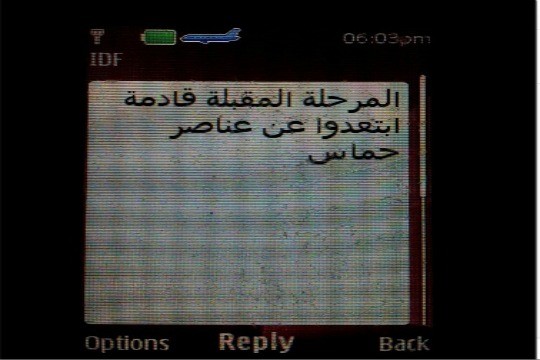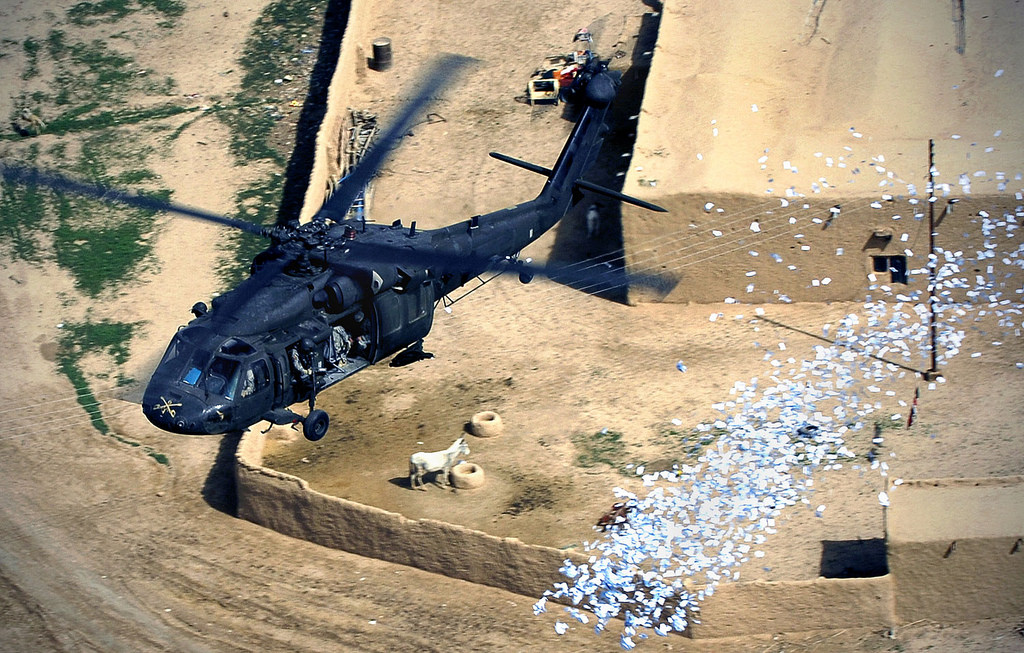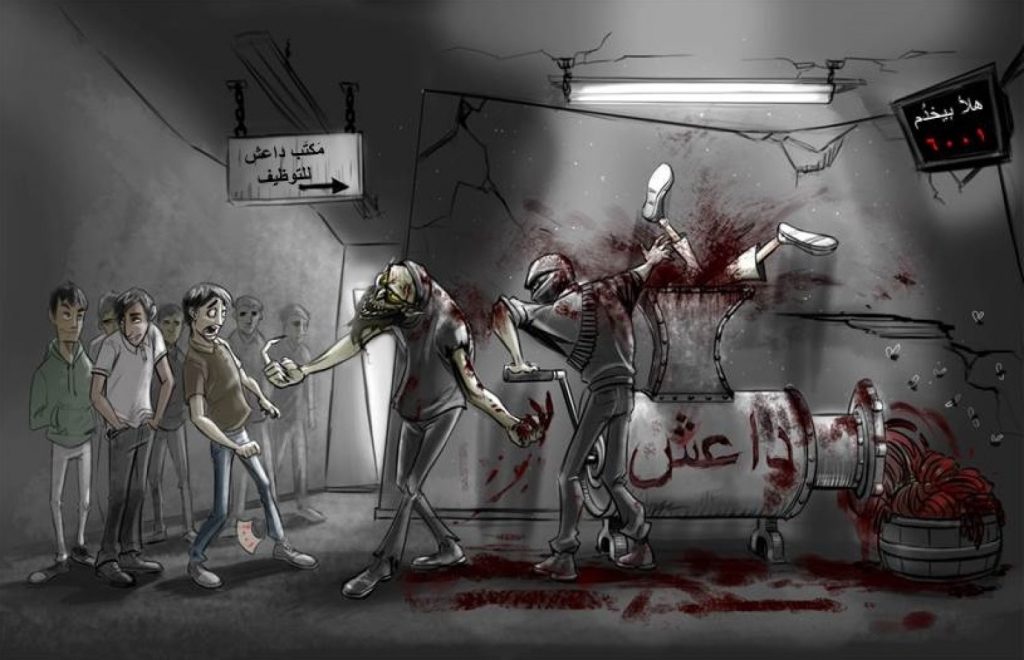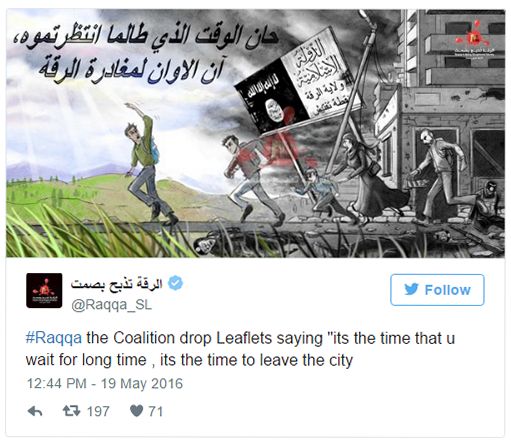Do Military Leaflets Save Lives or Just Instill Fear?
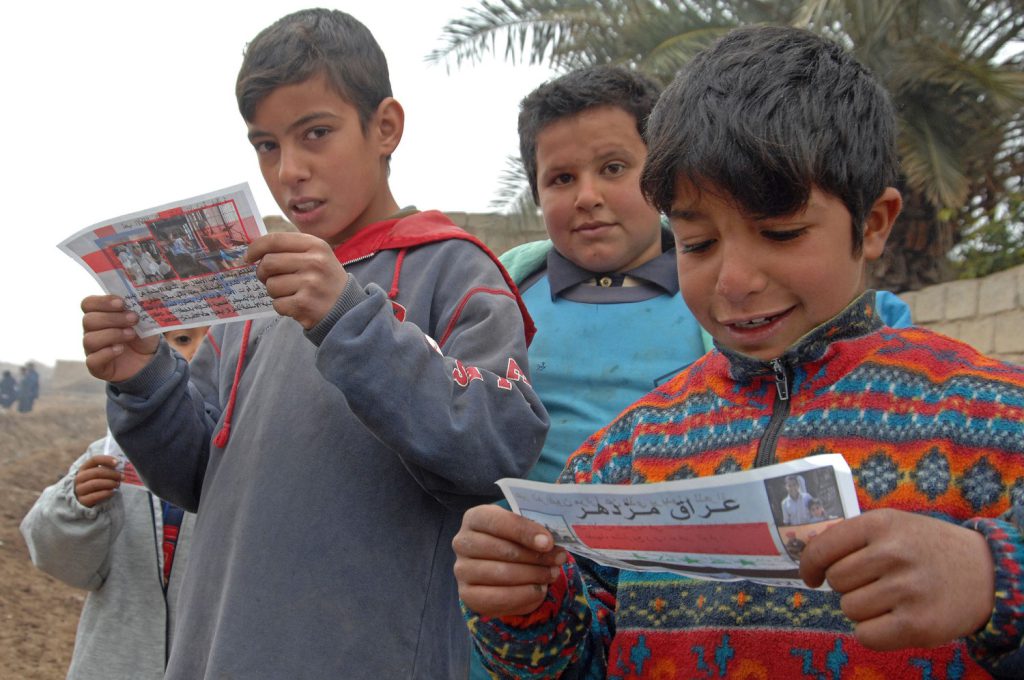
On November 14, 2012, the Israel Defense Forces (IDF) uploaded a 10-second video to their official YouTube channel. The video showed the targeted assassination of Ahmed Said Khalil al-Jabari, which had just been carried out by the IDF in the Gaza Strip. Al-Jabari was the head of the Al-Qassam Brigades, the military wing of Hamas, which rose to power as the governing body in Gaza following elections in 2006. The killing of al-Jabari marked the beginning of what the IDF called Operation Pillar of Defense. His assassination, and the fact that footage of the event circulated so widely via social media, showcased the increasingly high-tech means by which the IDF and other modern militaries around the world conduct war and disseminate information about their operations.
Two days after al-Jabari’s assassination, the online blog-based publication +972 reported that the Israeli army was sending warnings to Gazan civilians through mobile phones. Rana Baker, a writer whose father received the threat, tweeted a photo of the cryptic message. It stated in Arabic, “The next phase is coming, stay away from Hamas elements.”
By the time of Operation Pillar of Defense, the practice of sending widely distributed text messages to cellphones in Gaza was a well-established component of the IDF’s military strategy. The messages are sometimes sent to hundreds of thousands of mobile phones across the territory, but they can also be targeted to individual phones. Coupled with these text messages, the IDF also calls specific residents in Gaza on their cellphones to warn them of impending airstrikes on the buildings they occupy or those nearby.
Helga Tawil-Souri, a media scholar and professor of Middle Eastern studies at New York University, has argued that these text messages and phone calls represent components of the “high-tech enclosure of Gaza”—a “digital occupation” of sorts in the region. In addition to these modern methods of communication, the IDF also regularly employs a method that has a much deeper history: military leaflets.
As a linguistic anthropologist, I’m drawn to questions regarding how language intersects with the social and political world in which we live. That is why I am fascinated by military leaflets: papers carrying ominous messages or warnings that are dropped by the thousands over conflict zones. They represent a direct means of communication between states and civilians in some of the most politically charged environments in the world. Of course, this form of communication only travels top-down, highlighting the extent of a military’s power and influence inside a conflict zone. By analyzing the ways leaflets are being used in the Middle East today, we can gain a deeper understanding of what roles these messages play during war.
One key characteristic of leaflets as well as more modern forms of communication is overly vague wording—what linguistic anthropologists refer to as indeterminacy. Looking closer at the text message that Baker’s father and many others received, one thing that is striking is its lack of specificity. Recipients are simply told to “stay away from Hamas elements.” However, in Gaza, an area with over 1.8 million people living on 141 square miles, what constitutes a “Hamas element” is rarely straightforward. A number of the leaflets I discuss below also use this vague type of wording. What effect do these opaquely worded transmissions have on civilians during conflict in places like Gaza? What does the lack of specificity mean? Why are civilians only being provided with part of the story and given only a portion of the information that they need in order to avoid becoming victims of military strikes?
Within humanitarian frameworks that are intended to protect civilians during an attack, such as Protocol I, Article 57 of the Geneva Conventions, an “effective advance warning” is a way in which militaries are expected to notify civilians when attacks will likely affect them. Israel’s own rules of warfare on the battlefield stipulate that warnings should be given to civilians in advance of an attack. One practical effect of such messages is that they do, at least on the surface, provide civilians with a warning.
However, as numerous Gazans have conveyed—both in news reports and to me during my time conducting fieldwork in Gaza in 2013—communications from the Israeli military sometimes warn of strikes that never materialize, which some critics have described as a form of psychological warfare. In a report filed after Operation Cast Lead, the 22-day Israeli bombardment of Gaza that took place from December 2008 to January 2009, Amnesty International argued that “such random telephone calls, leaflets, and radio announcements did not constitute effective advance warning. They were too general and reached residents all over Gaza.” In short, Amnesty claimed that the IDF had failed to fulfill their obligations to civilians under international humanitarian law.
Despite the limitations and shortcomings of these generalized warnings, the messages have a strategic function. They allow the military to say that a warning was given. Providing such a warning gives the military space to maneuver in broader, often international, discussions surrounding their actions in conflict. That space is created by the linguistic content and structure of the messages, and the ways in which the language of these leaflets and text messages subtly shifts responsibility for the safety of Gaza’s residents onto the shoulders of civilians themselves. A leaflet that was dropped over Gaza during Operation Pillar of Defense illustrates how this occurs. Translated into English, it reads:
Important announcement for the residents of the Gaza Strip:
For your own safety, take responsibility for yourselves and avoid being present in the vicinity of Hamas operatives and facilities and those of other terror organizations that pose a risk to your safety.
Hamas is once again dragging the region to violence and bloodshed. The IDF is determined to defend the residents of the State of Israel. This announcement is valid until quiet is restored to the region.
Israel Defense Forces Command
By noting that civilians who don’t follow military instructions are putting their lives at risk, the message places the responsibility for safety on the civilians themselves. In framing the message as a warning, the military can carry out its operations with a lessened responsibility for civilian casualties.
Leaflets have been used similarly in other contexts to shift responsibility onto civilians. In late November 2016, The New York Times reported that Syrian government forces showered eastern Aleppo with leaflets warning residents that if they refuse to leave they “will be annihilated.” A particularly somber passage tells residents that “everyone has left you alone to face your doom,” calling on residents to abandon their city and flee rebel-held areas as the attack on Aleppo began. Ironically, according to the Times, around the time the leaflets fell, government aircraft dropped barrel bombs while civil society activists looked for safe corridors through which residents could escape.
Other examples from the Middle East illustrate the versatility of leaflets as a form of communication during conflict. While the leaflet from Gaza referenced above was largely framed as a warning, others are regularly used to explicitly conduct psychological warfare. Within the context of the Syrian Civil War, which began in 2011 and has displaced roughly half of the country’s population, the U.S. and Russia—as well as the Syrian government—have utilized leaflets in various forms. Many of these leaflets have relied on gruesome imagery to induce fear among both civilians and Islamic State militants throughout the country.
These messages often take the form of propaganda, such as a leaflet the U.S. military dropped over Raqqa, the de facto capital of IS, in 2015. The leaflet garnered wide international media attention for the violent imagery that it depicts, with Washington Post journalist Dan Lamothe calling it “stark and bloody, like something out of a graphic novel.”
Such forms of propaganda are often heavily visual, lacking many of the textual elements that are present in other types of messages, like those from Gaza. The controversial cartoon shows IS recruiters feeding civilians into a meat grinder labeled with da:‘iš, the pejorative Arabic name of the organization. The sign on the left, hanging from the ceiling, points in the direction of the “IS Recruiting Office,” while a television screen reading “Now serving number 6,001” hangs above a barrel of fly-infested ground meat.
A U.S.-led coalition dropped similarly grim leaflets over Raqqa in the spring of 2016. The picture depicts the city as a crumbling world of black and white, where weapons and dead fighters litter the ground. The text tells residents that “the time that you have been waiting for has come, the time to leave Raqqa” (my translation). In addition to instructing residents to leave, the leaflet delivers a glimpse of their potential fate should the instructions go unheeded.
This leaflet raised speculation that the U.S. would soon launch operations to retake Raqqa. At the time, however, Pentagon officials noted that no offensive was scheduled. Such confusion demonstrates the indeterminacy of these messages and their ability to induce fear regarding the potential for military actions. This leaflet, which was part of what the Pentagon described as a campaign to “mess with” IS, highlights that while it was ostensibly directed at the civilians of Raqqa, it also sent a powerful psychological message to IS members.
Messages like these compound the Islamic State’s reported paranoia regarding their ability to hold on to Raqqa in the face of Kurdish and U.S. troop advancement. That paranoia may be well-founded, given that coalition and Syrian Democratic Forces are now advancing toward the city. In April, leaflets dropped by the U.S.-led coalition over northern Syria provided civilians with conflicting directions regarding where they should go to seek safety. According to two activist groups that track combat deaths in the region, the resulting confusion may have resulted in increased civilian causalities.
As war becomes increasingly complex, tactics like leaflets remain a key method by which militaries manage conflict. Language in the context of war has the power to shift the responsibility for safety or the culpability for atrocity. It also holds a powerful capacity to induce fear and uncertainty among both combatants and civilians caught in the fighting.
Most of us will never see or interact with these forms of language because we never have to experience the daily realities of war. Because of our distance from the conflicts that we see playing out halfway around the world, it is easy to overlook that language has become a vital component of modern conflict. For the civilians living through war, though, while the leaflets themselves are often ambiguous, the threat of real violence behind the language used by militaries couldn’t be clearer.





























